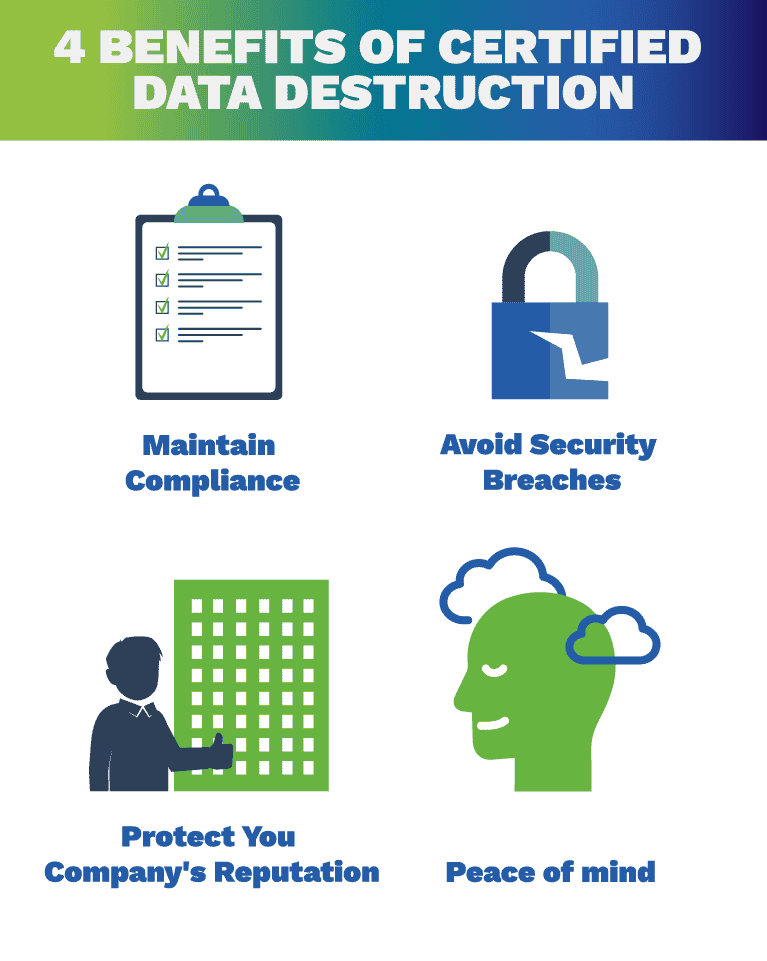Why Data Destruction is a Vital Element of Comprehensive Cyber Security
Why Data Destruction is a Vital Element of Comprehensive Cyber Security
Blog Article
The Value of Effective Data Devastation Practices in Safeguarding Sensitive Details and Ensuring Computer Safety
In an age where information breaches are significantly usual, the value of effective information devastation techniques can not be overstated. Organizations face considerable threats when delicate details is inadequately taken care of, potentially bring about unauthorized gain access to and extreme financial consequences. Carrying out durable information devastation approaches not just mitigates these risks but also aligns with legal compliance requirements, guaranteeing that organizations maintain their track record and foster customer trust fund. The concern stays: what particular techniques can be employed to boost these methods, and exactly how can organizations effectively incorporate them into their general cybersecurity structure?
Comprehending Data Damage
Understanding data devastation is essential in today's digital landscape, where sensitive details can quickly be endangered. Reliable information damage entails not just making sure yet erasing files that data is irretrievable via extensive approaches. This process is necessary for organizations that manage personal client info, copyright, or internal papers, as any kind of breach can cause extreme monetary and reputational effects.
Information damage incorporates various methods, consisting of shredding physical media, degaussing magnetic storage gadgets, and using software-based services that overwrite information multiple times. Each technique offers a specific function and must straighten with the sensitivity of the information being taken care of. Physical damage is commonly favored for tough drives containing highly confidential data, while software application approaches could be enough for much less sensitive info.
In addition, adhering to market criteria and policies, such as the General Information Security Law (GDPR) or the Medical Insurance Transportability and Responsibility Act (HIPAA), is vital for compliance and to alleviate legal risks. Organizations should establish a robust data damage plan, train workers on best techniques, and regularly investigate their procedures to make sure that all sensitive information is gotten rid of firmly and efficiently.
Dangers of Inadequate Practices
Inadequate information devastation practices reveal companies to significant threats that can have significant consequences. When delicate info is not properly disposed of, it continues to be susceptible to unapproved gain access to, which can lead to information breaches and identification theft. Such occurrences not only endanger the safety of people however also stain the organization's online reputation, causing a loss of client count on and possible monetary consequences.
Furthermore, governing compliance is increasingly rigid in lots of industries. Failing to follow data devastation laws can cause hefty penalties and lawsuits against companies. These fines can divert and stress economic resources interest from core organization operations.
In addition, the misuse of recurring information can lead to intellectual home burglary or company reconnaissance, jeopardizing competitive benefits (data destruction). The impact of insufficient information devastation extends beyond immediate monetary losses; it can likewise cause lasting damages to brand name stability and market setting

Organizations have to identify that information safety and security is not exclusively regarding stopping violations; it additionally incorporates the liable monitoring of information throughout its lifecycle. Neglecting effective data destruction protocols can have devastating ramifications, highlighting the requirement for durable actions to minimize these threats.
Ideal Practices for Information Destruction
Implementing effective data destruction practices is vital for securing sensitive information and preserving conformity with regulative requirements. Organizations ought to adopt a multi-faceted approach to make certain that information is irretrievable, thus avoiding unauthorized access and possible violations.
First, data need to be classified based on level of sensitivity, permitting companies to apply appropriate devastation techniques tailored to the level of threat. For electronic data, making use of software-based data-wiping tools that adhere to sector criteria can properly overwrite existing information. Physical damage methods, such as shredding or degaussing, are essential for devices that store delicate details, making certain full eradication.
Establishing a clear data retention policy is vital, describing the length of time various kinds of information need to be maintained prior to damage. Regular audits of data storage space systems are additionally essential to recognize unnecessary or out-of-date data requiring removal.
Furthermore, training employees on the importance of data devastation and the certain protocols to comply with fosters a culture of protection within the organization. Preserving documents of data damage refines offers liability and supports compliance with external laws and internal policies. By adhering to these ideal techniques, organizations can substantially minimize the risks related to data exposure.
Legal and Conformity Factors To Consider

Failure to comply with these regulations can result in extreme charges, consisting of considerable penalties and reputational damage. Organizations needs to implement a robust information devastation policy that lines up with these lawful frameworks and supplies clear standards on the proper techniques of information disposal, whether physical shredding or electronic wiping.
Additionally, keeping documentation of data devastation tasks is vital for showing conformity during audits or evaluations. By focusing on lawful and compliance factors to consider, companies can enhance their information security position and foster depend on with stakeholders and clients, inevitably contributing to a more safe information monitoring setting.
Benefits of Effective Data Damage
Efficient data destruction practices prolong past simple conformity; they supply significant advantages to organizations that prioritize them. By making sure that delicate info is irretrievably ruined, companies mitigate the danger of information breaches and the potential monetary consequences linked with them. This aggressive strategy not just safeguards versus unauthorized access but likewise boosts the overall trustworthiness of the organization in the eyes of stakeholders and customers.
Implementing robust information devastation methods, such as physical destruction of storage devices or sophisticated data wiping techniques, contributes to the strengthening of an organization's cybersecurity pose. data destruction. It minimizes the likelihood of copyright burglary and shields exclusive details, therefore keeping a competitive edge on the market

Conclusion
Finally, reliable data devastation methods are necessary for securing sensitive details and improving overall computer system security. By implementing detailed methods such as software, degaussing, and shredding overwriting, companies can minimize the risks linked with unapproved access and data violations. Adherence to regulatory requirements, consisting of GDPR and HIPAA, further reinforces compliance and secures versus legal repercussions. Ultimately, a commitment to robust information destruction strategies promotes a culture of obligation, consequently reinforcing a company's cybersecurity position and preserving go to website client trust.

Report this page